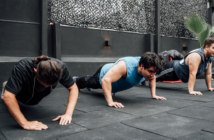Maintaining an active lifestyle is a key step to improving heart health. Physical activity not only strengthens the heart, but also helps manage your weight, prevents damage to your arteries, reduces high blood sugar, and combats high blood pressure.
You do not have to be an athlete to improve your heart health, and it’s never too late to start working out. Aerobic exercise and strength training is the most beneficial to heart health. Don’t forget to stretch! Although it is not the main contributor to heart health, improving your flexibility provides the support your body needs for aerobic and strength exercises.
The worst part about beginning to exercise is the mental dread of it. What exercises should you do? Do you prefer working out at the gym or home? What about trainers or group classes? Once you find what works for you, you will begin to enjoy exercising regularly. But how do these exercises boost your heart health?
If you’re looking to improve your heart health and overall well-being, keep reading to learn about the types of exercises you should include in your workout plan.
Aerobic Exercise (Cardio)
Aerobic exercise, or cardio, work by stimulating blood circulation throughout the body. During cardio, the heart pumps oxygenated blood to the working muscles. These exercises help lower blood pressure and heart rate while increasing your overall fitness. Aerobic exercises also improves your cardiac output and reduces your risk of developing type 2 diabetes. If you are already a diabetic, cardio can help control your blood sugar levels.
Aerobic exercise plans should be realistic, simple, and sensible. The aim is to perform at least 30 minutes of cardio a day for five days a week. If you prefer to work out in the gym, cardio machines such as treadmills, ellipticals, and spin bikes are popular exercise options. However, you do not need a gym membership to perform aerobic exercises. Other examples include playing tennis, dancing, swimming, jumping rope, taking a brisk walk, skiing, as well as many others.
When you’re performing cardio, you should move fast enough to raise your heart rate and breathe harder, but you should still be able to hold a conversation. If you can’t, you may be pushing yourself too hard. Low-impact exercises, such as swimming and walking, are recommended if you suffer from joint or back problems.
Strength (Resistance) Training
Strength, or resistance, training is an essential part of a completely balanced workout plan. It slows age-related muscle loss, builds muscle and tissue strength, proliferates bone density, diminishes the risk of injury, and soothes arthritis pain. Resistance training also improves control over blood sugar, minimizes the risk of falling, enhances balance, and improves mental health.
The bigger benefit? Strength training continues to burn calories for three to four hours after you complete your workout. It is especially important for people who are on diets. When you lose weight, as much as a quarter of the loss can come from your muscles, which may result in a slower metabolism. Resistance training helps shrink body fat and develop lean muscle mass. A combination of cardio and strength training helps increase HDL (good) cholesterol and decrease LDL (bad) cholesterol.
You can use free weights, weight machines, resistance bands, or your bodyweight to perform these exercises. Several different workouts target different parts of your body. Some examples of strength training exercises include squats, deadlifts, push-ups, lunges, and yoga. You should aim to perform resistance workouts two to three times a week, allowing a day for recovery between sessions.
Stretching and Flexibility Training
Flexibility workouts do not boost heart health directly. Rather, they improve the function of your musculoskeletal system, which keeps your joints loose, minimize pain, and reduce muscular issues. A solid musculoskeletal foundation is critical in performing aerobic exercises and strength training that boost heart health.
Improving your flexibility can help with your balance and preserve stability as you exercise, which inhibits falls that can cause injuries that may limit your ability to continue to exercise regularly. Experts recommend stretching daily, as well as both before and after you exercise.
Stretching is categorized as ballistic, dynamic, active, passive, static, isometric, or PNF stretching. Several basic stretches can be done at home or the gym, and your doctor can recommend specific stretches that you can do to target specific areas of concern. Group yoga or tai chi classes that aim to improve flexibility are also available and a great way to learn new stretches.
Myofascial release is a term that describes the use of specific tools, such as foam rolls, to improve muscle mobility. Applying pressure on tight muscles helps relieve abnormal tissue and improves blood flow, making the muscles more pliable and easier to stretch.
The muscles in the body are held together by a web of connective tissue called fascia. Therefore, improving muscle mobility in one part of the body also improves mobility in other parts of the body. Instead of a warm-up, myofascial releases work best for recovery after a long cardio session or heavy resistance training.









